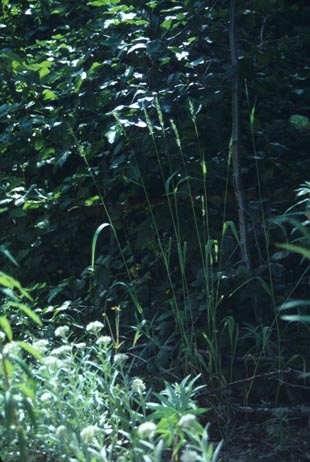Blue Wildrye

Common Name(s):
Blue Wildrye
Scientific Name:
Elymus glaucus Buckl.
Symbol:
ELGL
Description:
Life Span: Perennial
Origin: Native
Season: Cool
Growth Characteristics: Blue wildrye is an erect, rapidly developing bunchgrass. It is short lived and drought tolerant. Blue wildrye commonly grows in small tufts of only a few stems. The vigorous, fibrous root system is well branched and penetrates deeply. Blue wildrye may produce stolons or short rhizomes. Blue wildrye regenerates via rhizomes, stolons, and tillering. Flowers June through August.
Seedhead: The inflorescence is a dense, erect, narrow spike approximately 2.4 to 6.4 inches (6-16 cm) long. Spikelets are 2 or rarely 3 per node or solitary at the upper and lower nodes, and 2 to 4 flowered. Glumes are awn-pointed but broadened at the base. Lemmas about 3/8 inches long, shorter than the glumes, tapering into harsh awns which are 3/8 to ¾ inches long. Seeds have an awn that is up to 0.75 inch (1.9 cm) long.
Leaves: Leaf blades are flat, commonly ½ inch wide, and 2 to 12 inches (30 cm) long, and have a rather rough texture. The leaves are mainly grown on the stem. Ligules are up to 1/16 inch long, membranous, collar-shaped, auricles absent.
Stems: Stems range in height from 1.9 to 5.9 feet (60-180 cm) and form small, mostly loose tufts.
Ecological Adaptions:
Blue Wildrye habitat includes open woods, prairies, thickets and moist or dry hillsides. It is very common in the woodlands of the central Rocky Mountains, where it is a common component in quaking aspen (Populus tremuloides) and mountain brush communities. It exhibits intermediate shade tolerance and some populations are considerably drought tolerant. It occurs from near sea level in California to subalpine montane sites throughout the Intermountain Region. Within woodlands and conifer-dominated communities, blue wildrye is frequently associated with riparian areas. It normally occurs in areas where precipitation exceeds 15 inches annually, and is found at elevations from 4,297 to 10,496 feet (1,310-3,200 m) in Utah. Blue wildrye is typically favored by disturbances such as burning and logging
Soils: Blue wildrye grows best on moderately moist soils. Sites are characterized by low fertility and well-drained soils, with textures ranging from clayey loam to sandy loam. Plants are moderately sensitive to saline soils and are not tolerant of shallow soils. It generally prefers moderately acid to neutral soils (pH 5.2 to 7.0).
Associated Species: Common plant associates of blue wildrye in the western United States include alder, maple, sagebrush, brome grasses, bluegrasses, meadow barley, cinquefoil, strawberry, yarrow, aster, and Quaking Aspen
Uses and Management:
Blue wildrye is important forage for wild and domestic animals throughout its range. On quaking aspen sites in good condition in parts of Utah, this bunchgrass contributes substantially to forage resources. Blue wildrye is rated as only fair in forage quality because of its coarse foliage. Although plants are grazed into the summer, most use occurs in the early spring. New growth is highly palatable to horses and cattle; plants are utilized less extensively by domestic sheep. The awned seedheads are generally not consumed. Although blue wildrye has a fairly well-developed root system, plants are intolerant of continued heavy grazing. Recovery is generally rapid on overgrazed ranges when utilization is suspended.
Blue wildrye is unusual in that its growth appears to be compatible with tree regeneration. It has been recommended for revegetation on quaking aspen and mountain brush sites in Utah.
Blue wildrye seeds were probably used historically as food by the Salish of Vancouver Island.
Blue wildrye is included in a living collection of perennial Triticeae grasses in Logan, Utah. The collection is maintained by the USDA and the Utah Agricultural Experiment Station for applied research as well as genetics, evolution, taxonomy, and other elements of basic research.

